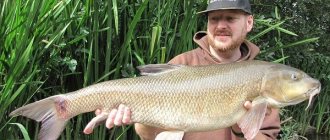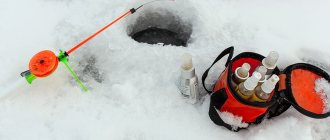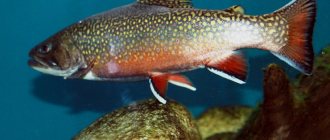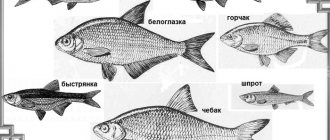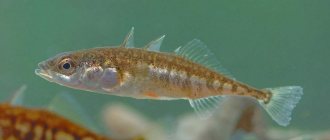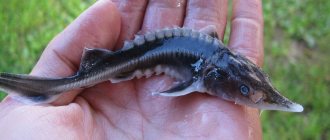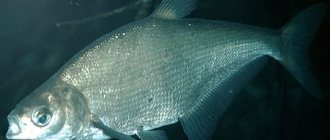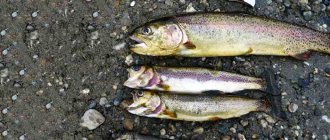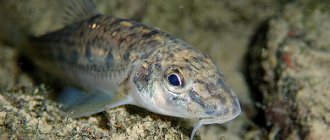What does Sopa fish look like? Description
The white-eye belongs to the carp family. In appearance it is similar to the freshwater fish bream. It is distinguished by a more elongated and flat body and a radiant long anal fin. Huge eyes with silver-white irises are located on a swollen, thick and blunt-shaped snout. Single-row pharyngeal teeth, long and dense gill rakers. The fish has a short dorsal fin, with three simple and nine branched rays, the upper lobe is shorter than the lower one. The body color is predominantly whitish-silver; on the dorsal part it is a darker shade with a bluish-lilac tint.
Of course, the sopa fish looks like a not very beautiful inhabitant of river spaces. However, its highlight lies in its large silver scales, which shimmer very colorfully under the sun’s rays. The scales fit tightly to each other. The fins are colored gray, and the tips on the dorsal and tail are black. Sopa lives for about 15 years, but they rarely live to that age. Sometimes you can find quite large specimens weighing up to 1.5 kg and about 50 cm long.
Description of the species
Despite the common features with bream fish, the bluegill (lat. Ballerus ballerus) is not their closest relative, but forms its own family branch, which, in addition to it, includes the white-eye (lat. Ballerus sapa).
The species received a catchy and easy-to-remember name for the color of its back in dark blue tones with a green tint, which, in combination with a light belly, corresponds to a protective (concealing) color according to the principle of countershadow.
The protective mechanism is adjusted to diffuse overhead lighting, which is typical for all bodies of water. Due to the fact that the shadow falls on the light areas of the body, the fish visually acquires a monotonous color and merges with the surrounding background.
Other features of the blue chinese's appearance include:
- elongated high body (maximum width 1/3 of length);
- flattened sides of a silvery-white color;
- small scales of cycloid shape (with a rounded posterior edge);
- pointed head with terminal mouth turned upward;
- arched lateral line.
The appearance characteristic of the species is also formed by unusual yellowish-gray fins: high and short dorsal, very long (35-45 rays) anal, with a notch and built-up caudal lobes.
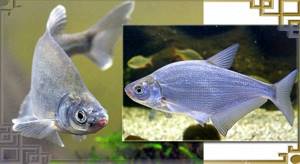
Maximum size of blue
The fish does not amaze with its size - the catches contain specimens 200-400 g long and 20-30 cm long. In large rivers and reservoirs with a rich food supply, individuals 40-45 cm tall and weighing over one kilogram are found. The largest bluebird weighed about 2 kg, which is mentioned in some authoritative sources, for example in the “Encyclopedic Dictionary of Brockhaus and Efron”.
To learn more:
Ruff: spiny perch fish
Differences between bluegill and white-eye and other fish
Many common nicknames (sintepa, sinchik, singa, sintyavka) clearly indicate the main external feature that allows one to accurately identify this species of cyprinids - the sapphire-olive color of the back. Difficulties may arise only for inexperienced fishermen who will need to distinguish bluegill from other fish of similar body shape and size: bream or white-eye.
Here you don’t need to look for subtle differences in fins, scales, color, but just pay attention to the structure of the mouth: it just looks down - it’s a white-eye (popularly called a glander, eye-catcher, klepets), and if the lips additionally form a retractable tube, it’s a juvenile bream ( white bream).
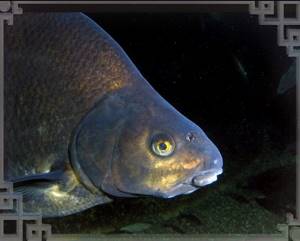
Podleschik
Habitats
Where is the sopa fish found? She prefers fast-flowing rivers flowing into the Black and Caspian seas, river basins:
- Ural;
- Dnieper;
- Don;
- Kuban;
- Dniester,
- Vyatka;
- Buga.
It is practically not found in the waters of the Lower Volga and Kama. The South Caspian white-eye can be observed off the coast of the Caspian Sea. For example, in the Saratov region this is a very well-known catch for professional fishermen. Despite its seemingly widespread distribution, it is still a rather rare species and its catch is mostly accidental when hunting blue bream and bream. Sopa fish looks like a small bream fish with a humpbacked and blunt snout. And the presence of huge bulging eyes was one of the reasons for the different names of this fish in different regions of the country: glazach, goggle-eyed. Almost every region calls it differently.
Differences from related species
In fishing literature, the white-eye is often called a “sop.” Due to their external similarity, many fishermen confuse the white-eye with young bream, silver bream and blue bream, but upon closer examination a number of differences can be found. Sopa differs from its closest relatives in its smaller body height. This is due to the fact that the white-eye lives only in bodies of water with a current, where a tall body makes it difficult to maneuver in the flow of water. In addition, the white-eye is distinguished from bream by its more modest size. If an adult bream can weigh more than 5 kg, then the maximum weight of the sopa is limited to 1 kg with a length of about 35 cm.
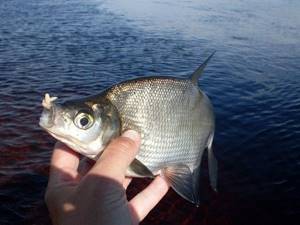
A bunch of maggots is an excellent bait for fishing for white-eye during the entire period of open water.
The sopa differs from the silver bream in the color of its fins and eyes. The fins of the silver bream are red, while the fins of the white-eye are pale gray. The eyes of the silver bream are distinguished by a yellow or orange iris. The iris of the sopa's eyes is white, which was the reason for the name of this fish.
On a note! Sopa can be distinguished from blue bream by its larger scales and blunt snout shape. While the blue-eye's scales have a distinct blue tint, the white-eye's scales are silvery.
Lifestyle
Sopa is a river fish and very cautious. Young animals stay near the spawning grounds for a short period, and adults choose deep, more than three meters, clean areas of reservoirs with a fairly strong current.
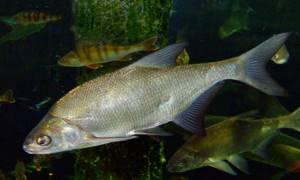
They lead a sedentary lifestyle, living in small flocks, which become larger before winter. For the winter they go downstream, choosing deep depressions, and in early spring they return to the spawning grounds. In case of lack of oxygen, the white-eye tries to stay near the springs.
Habitat and behavior
Sopa fish lives only in the European part of Russia; it is found in the following areas:
- Kama and its tributaries (occasionally);
- basins of the Caspian and Black Seas;
- Aral Sea basin;
- rivers Northern Dvina, Vychegda, Volkhov.
They prefer to live in small flocks. In the fall, before the cold season, they huddle in deep depressions in the lower waters of rivers, which is why winter fishing for white-eyes is extremely difficult. Adult white-eyes prefer deep water, uneven bottoms and fast currents. The young live in the same place where spawning takes place - in shallow water. Depending on the abundance of food, the sopa can remain in one place for a long time or migrate in search of better conditions.

White-eye
Reproduction
Sopa fish reaches sexual maturity at the age of 4–5 years, when it gains a body weight of 100–200 g and a length of about 20 cm. Male individuals mature a year faster. Before breeding and throughout this period, males develop a pearly white rash on the body and head. Sweeping occurs when the water temperature is not lower than 10 degrees in the floodplains of the rivers in the second half of April. Spawns simultaneously on the rocky clean bottom of the reservoir. The number of eggs varies among females of different age groups. In large individuals, weighing about 500 g and body length 27 cm, there are from 18 to 20 thousand eggs, in smaller ones - from 8 to 12 thousand, according to available data, relative fecundity ranges from 30 to 80 eggs per gram of body weight fish. The eggs are large, 1.7 mm in diameter.
Catching whiteeye during the open water season
It is not always convenient to fish with float gear in the places that white-eye prefers. Most likely, fishing with donkeys, a feeder and its lightweight version – a picker – will be more successful. These tackles allow you to fish in strong current conditions without missing a bite. The feeder rod is selected based on the fishing conditions, but more often these are fast action forms, with a test weight of more than 100 grams, and a length of more than 3.6 meters. A suitable inertia-free reel of size 4000 or 5000 should be selected for the feeder. Feeders are often used heavy, with additional lugs, which allow them to stay on the bottom even in conditions of pronounced current.
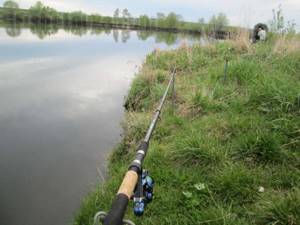
Photo 2. Fishing for sopa on a feeder.
It is generally accepted that sopa responds well to the use of bait. For this purpose, both homemade and purchased mixtures are used. The bait most often used is maggots and red dung worms, and a little less often steamed wheat and pearl barley. A characteristic feature of the white-eye is also that during the summer it remains active at night.
Important! For successful fishing in currents, the bait should be stickier and also slightly more moist than in the case of fishing in reservoirs with weak or no current.
The capabilities of float gear should not be underestimated. Bolognese, as well as the simplest fly rods, are sometimes also effective. Lapdogs can bring especially good results when fishing with a line, because the current itself can carry the float and hook with bait to the fish’s resting places.
Does Sopa feed on young fish?
The growth and nutrition of the clawfish varies throughout its life. The young grow quite quickly, adding up to 5 cm in length every year. At the age of three years, the white-eye weighs approximately 65 grams. After maturity, after reaching five years of age, growth slows down.
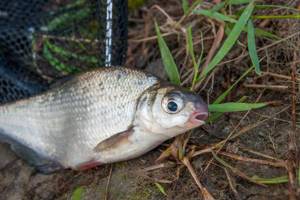
After spawning, the eyefish feeds intensively. The diet depends on the age of the fish. The fry prefer small-sized zooplankton floating in the water surface. Grown-up juveniles add amphipods and aquatic insects to their diet. At an older age, the fish feeds on crustaceans, bottom crustaceans, toothless crustaceans, and pearl barley. Sopa fish obtain food in the bottom layers and often swallow sand along with it.
Features of hunting white-eye
They catch sopa with a bottom bit. The fishing line is taken 0.2–0.3 mm, the hook is used in the size range from 4 to 6. The role of bait is performed by maggots, bivalve meat, and worms. It is very difficult to catch it, due to the fact that the white-eye feeds on animal and plant food. Nevertheless, this bait can easily attract representatives of the carp family, but not sopa. White-eye also lives far from the coast, at depth with strong currents - all this creates difficulties in catching. According to fishermen, sopa fish like dung and earthworms as bait. You can catch this fish on a long-cast bottom using a spinning rod with a spinning reel and a sinker of about 40 g. In addition, for a successful catch you need:
- Spring flood.
- The right place, namely, the bottom of the reservoir should be solid. Sopa is a careless fish, so a bite may occur when the bait is on the bottom.
- Evening time.
Fishing Features
Our fish is found in the river basins of the Caspian and Black Seas. Occasionally, fishermen observe its appearance in the rivers of the Baltic and White Seas; there are known cases of finding isolated schools in the Aral Sea and the Kama River. It gathers in large flocks, loves rocky and sandy bottoms, and avoids muddy areas. Swims mainly in fast-moving rivers and does not move long distances from its favorite place.
No matter how much this individual is found in the rivers, it can still be difficult to catch: it is unevenly distributed in the water. Considering that it is often found on the border of fast and slow currents, you can catch white-eye with a bottom fishing rod (or donka) - the fish is well held in the water due to the weight of the feeder. Fishing gear like a feeder or picker is also suitable. The choice should be determined by the conditions in which the fishing takes place. It should be borne in mind that the fish treats them with extreme caution and even some sensitivity when it comes to fishing. Therefore, as soon as you notice even the slightest movement of the rod tip, hook the fish immediately!
Important! To ensure a successful catch, it is recommended to use additional lugs for feeders (preferably heavy ones) - in strong currents they will easily make fishing possible.
An important aspect is the choice of bait and bait. You can either buy the bait mixture at a fishing store or prepare it yourself. Sopa fish often swims on blowfly larva (maggot), mosquito larva (bloodworm), earthworm, dough or pearl barley and other cereals (they should be used especially in the summer).
This is interesting! Fish are attracted to various odorous substances. The crumb of bread or worms is often soaked in hemp or linseed oil. You can also drip anise and mint oils, camphor onto the bait.
The opinion that sopa fish cannot be caught with a float rod is incorrect. Still, it is worth noting that these fish can be found in still water and in slow currents. However, in terms of the features and amount of equipment used in these cases, such fishing looks like professional fishing with a catch of carp.
Interesting fact! The white-eye maintains an active lifestyle even at night.
Fishing in summer
The best time for biting sopa fish (its description is given above) is considered to be the period after spawning. For fishing, choose a deep place. Choose a fly or bottom bit; it is important to have sensitive tackle.
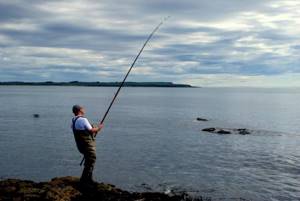
The thickness of the fishing line and the size of the hook must correspond to the parameters of the fish being caught. The size, weight and quantity of cargo are selected depending on the strength and depth of the current. The main thing is not to overdo it with bait. Due to the fact that the white-eye is not voracious, once it is full, it will simply leave and you will be left without a catch.
Catching Sop
Sopa belongs to the category of fish that are caught both in summer and winter. Therefore, white-eye fishing can last all year round. Given the random nature of her capture, few people go out to specifically hunt for her.
Choosing a place to catch sopa
Favorite habitats for flocks of Sopa are:
- deep areas of the reservoir, it is there that they find the necessary food for food;
- channel ditches;
- bottom pits;
- under the slopes at the lower edges;
- rare, but you can find them near hydraulic structures and bridge piles.
The white-eye prefers reservoirs with a rocky or sandy bottom, where there are no strong thickets, and the optimal depth for its habitat is more than 3 meters.
At shallow depths, most often, the young generation of sop is found, feeding together with bream and silver bream. Successful catching of white-eye in winter can only happen if its wintering holes are discovered at the bottom of a ditch near the coastline.
Tackle
To catch sopa, given the characteristics of its habitat, there is no point in using float gear.
Here it is more advisable to use all kinds of bottom equipment:
- ordinary donka;
- elastic band;
- snack;
- feeder.
To equip the fishing rod and bottom tackle, use:
- high-quality fishing thread with a diameter of 0.16 mm, for leashes (30-40 cm) - fishing line with a thickness of 0.12-0.14 mm;
- hooks No. 10-7, and according to the international classification No. 5-6 PK. When choosing a hook, you should also focus on its compliance with the intended bait. For example, if you will be fishing for sop using bloodworms, it is recommended to purchase a hook made of thin wire.
To equip the feeder use:
- heavy feeders, weighing 40-80 grams, depending on fishing conditions;
- rod weight test;
- for fishing from the shore, the recommended rod blank is over 3 meters, and for fishing from a boat - half a meter shorter;
- the tip on the rod should be quite rigid, taking into account the strength of the current in a particular body of water;
- a high-quality inertia-free reel with a spool capacity of more than 100 m of suitable fishing line.
Bait
It is recommended to use bait of animal origin as bait. In the spring and autumn season, Sopa gives its preference to bloodworms, maggots, dung worms, as well as tasty sandwiches (various combinations of these baits).
For the summer period, it is better to focus on vegetable attachments: pearl barley, dough, mastyrka.
It should be remembered that regardless of the nature of the bait, it must sit securely on the hook. This is due to the unique ability of the sop to pull the bait and not catch on the hook.
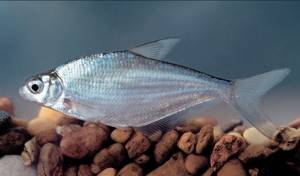
The white-eye bite is cautious, so even the slightest movement of the float or quivertip (top) can signal an upcoming bite.
The hook should not be sharp, so as not to injure the lips of the prey. Otherwise, the sopa will break down and leave.
Fishing for the sop occurs carefully, slowly, without sudden movements, so as not to scare away the remaining flock.
In general, the fishing process does not cause any particular difficulties for the fisherman.
Bait for catching sopa
Bait for catching sopa is used extremely rarely; places for hunting bream are often baited, and other species of aquatic inhabitants come here. Small fish appear first, then silver bream and sop, and only after a certain time bream and carp.
The optimal complementary feeding option for sopa is considered to be a mixture of grains and various cereals in combination with animal ingredients: chopped worms, bloodworms, maggots, chopped toothless meat.
You can also use a dry mixture for baiting white fish, purchased at a specialty store.
Fishing for sopa in winter
Fishing for sopa in winter has its own characteristics:
- Given the severe oxygen starvation of the white-eye during this period, it can be found near springs, on the edges of the river bed, near coastal gullies, and at river bends.
It is advisable to study or collect information from local fishermen about the underwater landscape of a particular reservoir, otherwise you may be left without a long-awaited catch; - after the place has been chosen, it is necessary to drill the hole as quietly as possible so as not to scare away the object of fishing;
- feed the area using vegetable baits with the addition of chopped pearl barley or bloodworms;
- Bloodworms, maggots, worms, and burdocks are ideal baits. It will also be relevant to use a jig in the form of a doll, cone, or pellet;
- To hunt sopa in winter, a nod and a float fishing rod are used. The fishing rod must be of high quality and strong enough;
- equipped with a hard nod and a jig weighing 10-15 grams. Recommended line thickness 0.1-0.15 mm;
- hooks No. 3-5;
- The length of the leash is 30-40 cm, knitted at a distance of 10-15 cm from the jig.
Even if all winter fishing conditions are met, do not forget about the rules of fishing: the movements of the bait must completely imitate the natural movements of the white-eye food.
Fishing for sopa, regardless of the time of year, is quite exciting and varied. By carefully preparing and collecting all the necessary information about the reservoir where you plan to hunt for sopa, you can not only have a good time, but also get a significant catch.
Fishing in winter. Interesting Facts
During this period, the amount of oxygen in the reservoir is important for the sop, so it actively moves towards the greatest oxygen saturation of the water expanses.
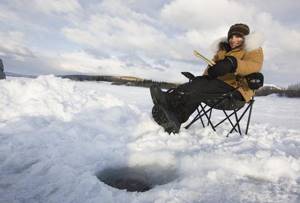
And one of the tasks facing fishermen is to find the place where the fish stopped. If such a place is found, a successful bite is guaranteed. If the bite suddenly stops, you should look for a new place, since the school of fish has moved up or downstream. During the fishing process, you should constantly monitor new movements of fish and follow them. There is no point in waiting for a catch in one place; the effectiveness will be practically zero. The success of winter fishing depends on how thoroughly the angler has familiarized himself with the features of the reservoir: what the bottom is, the topography, whether there are underwater keys, and other equally useful information for successful fishing. Basically, sopa fish (described above) are caught using a moving bait with a nod and a jig or a stationary bait with a float. The action of the jig should be smooth with a small range of motion without sudden twitching. When fishing with fixed gear, the float is sunk into the hole one centimeter below the water level.
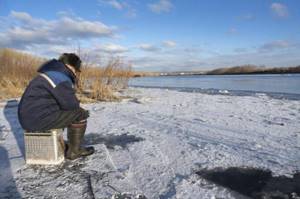
This method of fishing is due to the fact that the fish’s bites are weak and barely noticeable, so if even a thin crust of ice forms, it will delay the float and the bites may simply not be seen. There are cases when fishermen, who did not observe a bite, pulled out the tackle to check the bait, and there was a sopa fish on the hook.
Fishing, storage and bait
Biting on bloodworms, i.e. red worm is good for several reasons:
- Sopa looks for familiar prey in the water.
- Due to its rich color, the centipede mosquito larva is visible from afar.
Bloodworms can be found in rivers and ponds at any time of the year. It lives in silt, from where it is extracted using special devices. When buying bloodworms, you need to go around several sellers. You should take the product with the best appearance: large, clean specimens with the brightest red color (this indicates the freshness of the larvae). Store the worms in a damp rag (not a bunch in one place), which is placed in a deep container with damp sand. The container is placed in a cool place.
Fishing for maggots is more common abroad. It is easy to obtain larvae: a liver, a lung, a piece of meat or a small fish must first be cut into and left hanging in the sun. After some time, when the blowflies have gathered around and lay eggs in the cuts, place the meat in a closed container with wheat bran. After about 72-96 hours, the maggots are transferred to another container with bran and wait until the black spot inside the larvae disappears. Once they are cleaned, they should be stored in a dry container that must be tightly closed.
In addition to the above animals, fishermen often use bait (before or during fishing). Usually the same thing that is used for bait is thrown into the water. If the current is sluggish and slow, then the bait is thrown near the hook itself. If the current is fast, then it would be more advisable to throw it above your fishing spot. Used as bait:
- Chopped pieces of meat;
- Fish entrails;
- Snails;
- Wheat and rye bran;
- Legume grains;
- Crusts of bread.
It is important to remember that such bait is a stimulation of the dog’s appetite, and not full saturation. Therefore, additional additives should be added to the water in small quantities. Moreover, if the bite is good, then the use of bait is not even recommended. The bait is most suitable in cases where you managed to catch a large fish that scared away all the living creatures around at the time of catching.
Use in cooking
The meat is tender, but spoils very quickly, and is inferior in taste to blue salmon and superior to bream. Consumed fried, smoked, salted, boiled. To prepare cold-smoked white-eye, cutting methods are used: gutted with the head, fillet, carcass, balyk. For hot smoking, fish is used gutted, with or without the head, cut into pieces. Sopa dried fish is very tasty. Prepared in this form, it even competes with sabrefish for the title of the best fish for beer. Whole fish is used for cooking. They dry it in the following way:
- Fresh fish is placed in a saturated saline solution.
- Keep in solution for several days.
- Wash well.
- Dry in a cool and dry place.
The fish soup has an unusual and memorable taste, the broth in this dish is transparent, and silvery specks of fat float on the surface.
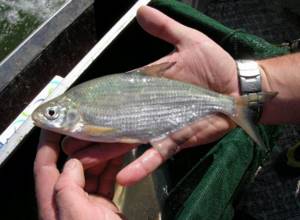
Some people mistakenly believe that blue fish, sopa and bel belong to the same breed of fish, but this is an incorrect judgment. Belle are non-predatory fish, weighing no more than 500 g. Bluefish and sopa belong to completely different species, although they are slightly similar in appearance. Sopa has larger scales and eyes. These fish prefer to stay away from the shores, closer to the bottom in places with fast currents.
